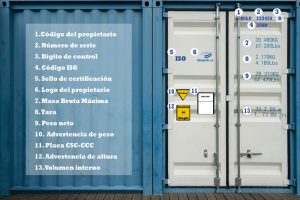The container is the basic mainstay of international trade. These metal receptacles are in constant movement, carrying goods the length and breadth of the globe. That’s why it is important to keep control over them at all times, something which is achieved with an internationally standardised registration system.
If you examine a container closely, you will find a whole series of identification markings. These markings provide essential information for all stakeholders in the supply chain, helping to track and guarantee safety of the container and, therefore, of its load, from the moment of its shipment until delivery to its destination.
Thus, all containers participating in international logistics must register with the BIC (Bureau of International Containers) and be identified with a series of ISO codes. Although Bilogistik is responsible for your shipments from start to finish, so that you don’t have to worry about dealing with these codes, here we explain each one and what they consist of.
Container number
This is the most prominent marking appearing on the container door. It is an alphanumeric sequence composed of 4 letters and 7 numbers. While to the uninitiated eye it seems to be a mysterious code, it is deciphered as follows:
- Owner code: These are the first 3 letters and identify the container owner as registered with the BIC. These letters are unique to all containers belonging to the same owner, although you must remember that it’s not always the owner who operates the container, since it can be rented to another operator or shipping company.
- Product group code: This is the fourth letter, which is the letter U in the case of ISO shipping containers. There are other alternatives, such as the J for container-related equipment and the Z for trailers.
- Serial number: 6 numerical digits freely chosen by the owner. Each container belonging to the same owner must have a different serial number to enable their individual identification.
- Check digit: A single framed digit. In a similar way to bank cards, this check digit provides a means of verifying that a serial number sequence is correct.
ISO Code
Container names can vary internationally. For example, a standard 20-foot container may be known as a Dry Van (DV), General Purpose (GP), Standard (SD) or Dry Container (DC). The ISO Code exists to get around these conflicting names. It takes the shape of a serial number with 4 digits which resume some of the container characteristics, as follows:
- Length: The first digit to appear is a 2 for containers measuring 20 feet, or a 4 for those measuring 40 feet.
- Height: The second digit tells us their height on a scale of 0 to 5.
- The last 2 digits indicate the container’s particular qualities.
Capacity markings
Under the ISO code, a series of indications are available which give details of the gross mass and its tare.
- MGW or Maximum gross mass: This is the maximum permissible weight of the full container, indicated in both kilograms and pounds.
- TARE: This is the weight of the container when empty. Also in both units.
- NET: The net weight which can be loaded into the container, in kilograms and pounds.
- CAP or Interior volume: The container capacity, in this case given in both feet and in square metres.
CSC and CCC plates
On the left-hand side of the container doors is the plate certifying that the container conforms to Container Security Convention standards. This plate contains information on the structural conditions and safety of the container. It is usually combined with the CCC (Customs Convention on Containers) plate, certifying that approval of the customs system has been obtained.
Other indications
An international goods transport container may also carry additional and optional markings such as:
- Owner markings: The owners or lessors of the container may put their logos on it.
- Indications of weight and height: A yellow triangle will provide an indication when the container is particularly heavy. A yellow box will provide an indication when the container exceeds the standard height envisaged for the type of container in question.
- Other certificates: Indications can also appear on the actual container when they have been the subject of audits or additional controls.


